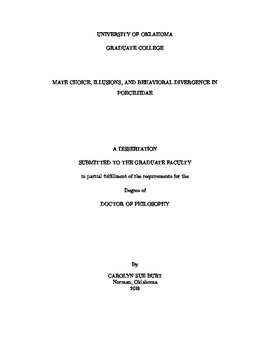| dc.description.abstract | Chapter 1: Illusions are commonplace and distort perception in ways that make objects appear different from reality. Such phenomena may also play a role in mate evaluation because body size and ornament size are signals shaped by sexual selection. Evolution of use of illusions through modifications of color patterns, environmental conditions, or behaviors may be common, yet are poorly understood. The Ebbinghaus illusion refers to the distorted perception of the size of an object depending on the size of surrounding objects, and is traditionally shown using Titchener circles. Because female sailfin mollies (Poecilia latipinna) choose mates from shoaling groups of males, I predicted that they would be susceptible to this illusion during mate selection. Specifically males surrounded by smaller Titchener circles (or conspecifics) should be preferred over those surrounded by larger circles (or conspecifics). I tested this prediction by presenting females with males at the center of an Ebbinghaus illusion, surrounded by Titchener circles, designed to make them appear either larger or smaller. I further tested this prediction using fish animations with focal male fish flanked by either larger or smaller males in shoaling groups. Females consistently chose the male flanked by smaller Titchener circles and this illusory effect endured when I replaced the Titchener circles with fish. Traditionally attractive larger males were not chosen, which is also consistent with predictions of the Ebbinghaus illusion. These results show that a male’s immediate environment can have a strong effect on generating a deceptive body-size perception to potential mates, and demonstrate that males have the potential to manipulate matings using the Ebbinghaus illusion.
Chapter 2: Identifying how signals can distort the receiver’s perception of reality is key to understanding signal evolution. Perceptual biases present in the receiver can create an inaccurate or incomplete perception of an environment, leading to sub-optimal decision-making. In some circumstances, signaling animals are able to deceive receivers by exploiting perceptual illusions, such as the Ebbinghaus illusion. Female sailfin mollies (Poecilia latipinna) have been shown to be susceptible to the Ebbinghaus illusion in a dichotomous choice experiment with contrasting illusions shown at the same time (Chapter 1). However, whether or not sailfin mollies remember the illusory effects while making mate choice decisions remains in question. Here, I tested whether this effect would persist over time using two experiments. In the first experiment I used live flanking males to induce the illusory effects. In the second experiment I used inanimate objects to mimic the Titchener circles found in the classic Ebbinghaus illusion. Specifically, I tested female preference for a male by sequentially presenting the same focal male with three different illusory contexts: 1) focal male flanked by smaller males or smaller inanimate objects, 2) focal male flanked by larger males or larger inanimate objects, or 3) focal male flanked by similar-sized males or inanimate objects. I predicted that, if memory plays a key role in signal interpretation, female Poecilia latipinna would be susceptible to the effects of the Ebbinghaus illusion sequentially during mate choice. I found that female Poecilia latipinna choice was not influenced in the absence of inducers — both for flanking male treatments and the inanimate stimuli. This pattern suggests that the impact of the illusion was not remembered and did not impact subsequent preference. Thus, illusory effects may only impact mate choice while the receiver is assessing the signal in real time, using working memory, and may not affect longer-term memory.
Chapter 3: Toxic sulfide springs create particularly harsh environmental conditions, driving divergence in physiological, life history, morphological, and behavioral traits. Although few invertebrates or vertebrates can live in hydrogen sulfide springs, several lineages of livebearing fishes have adapted to sulfidic environments. One key behavioral adaptation that can be measured across populations is the performance of aquatic surface respiration (ASR), where organisms in hypoxic conditions exploit the higher dissolved oxygen content at the surface of the water. Generally, organisms that live in sulfidic habitats are highly vulnerable to extinction owing to the small spatial extent of the habitat, which only supports very small populations, and makes them vulnerable to extirpation by localized natural processes, human activities, and accumulation of deleterious mutations. One such species is the endemic Limia sulphurophila, found in a single, small public sulfidic spring on Hispaniola. A closely related species, L. perugiae, is historically found downstream and provides a comparative reference for testing ASR in a non-sulfidic species. In this study I (1) characterized the environmental parameters of this system’s sulfide-freshwater gradient and (2) evaluated differences in behavioral traits (ASR) between L. perugiae and L. sulphurophila. I assess behavioral divergence between populations based on time performing ASR to examine whether species could survive outside of their locally adapted environment. I quantify differences in a behavior (ASR) typically found in species adapted to sulfidic condition. This evidence is consistent with the hypothesis that behavioral and physiological adaptions may have arisen multiple times in Poeciliids due to strong selection pressure in an extreme environment. | en_US |
